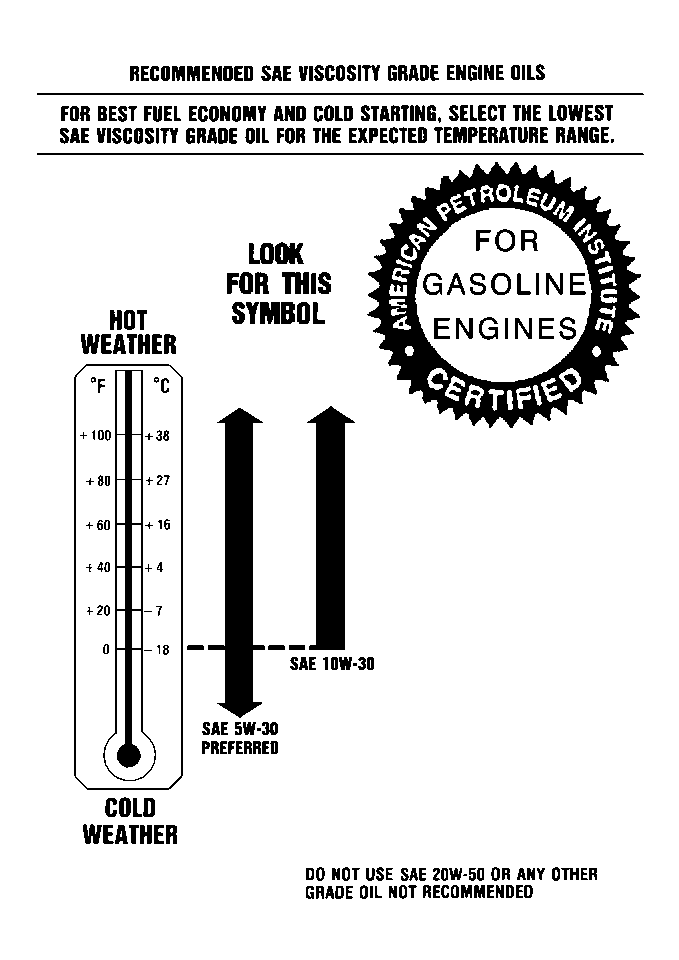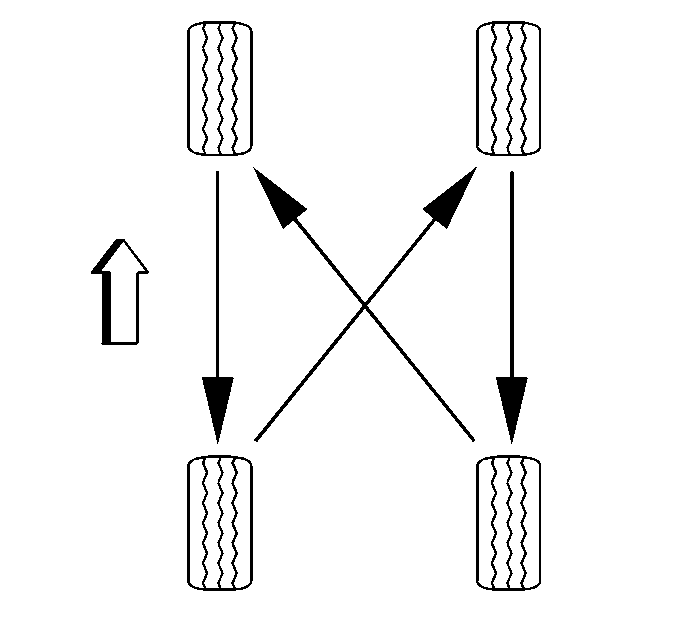Engine Oil and Oil Filter Change
Replace the engine oil and the engine oil filter. Refer to Engine Oil and Oil Filter Replacement .
Engine Oil Quality
Oils of the proper quality for the vehicle can be identified by looking for the Starburst symbol. The Starburst symbol indicates that the oil has been certified by the American Petroleum Institute (API), and is preferred for use in gasoline engines.
Engine Oil Viscosity

The recommended oil viscosity for this vehicle is SAE 5W 30.
Engine oil viscosity thickness has an effect on the fuel economy and the cold-weather operation engine starting and oil flow. Lower viscosity engine oils can provide better fuel economy and cold-weather performance. However, higher temperature weather conditions require higher viscosity engine oils for satisfactory lubrication. When the temperature will be 0°F (-18°C) or above, use SAE 10W 30. If the temperature falls below -20°F (-29°C), consider using an SAE 5W 30 synthetic oil or an SAE 0W 30 oil. Do not use viscosity oils such as SAE 20W 50.
Notice: Using oils of any viscosity other than those recommended could result in engine damage. When choosing an oil, consider the range of temperatures the vehicle will be operated in before the next oil change. Then, select the recommended oil viscosity.
Oil Filter
Remove the old filter by turning counterclockwise. Clean the gasket sealing area on the engine oil filter mounting surface. If the engine has an adapter base, make sure threaded nipple or bolt is properly tightened. Lightly oil gasket with clean oil and install filter. After the oil filter gasket contacts the oil filter mounting surface, tighten 3/4 to 1 full turn. When necessary, use a cap type wrench, AC Delco OF17W or equivalent or strap type wrench with swivel handle to insure proper installation. With engine oil level at proper level, run engine three minutes and thoroughly check filter area for leaks.
Tire and Wheel Inspection and Rotation
Tires should be rotated every 6,000 to 8,000 miles (10 000 km to 13 000 km).
Caution: Rust or dirt on a wheel, or on the parts to which it is fastened, can make wheel nuts become loose after a time. The wheel could come off and cause an accident. When you change a wheel, remove any rust or dirt from places where the wheel attaches to the vehicle. In an emergency, you can use a cloth or a paper towel to do this; but be sure to use a scraper or wire brush later, if you need to, to get all the rust or dirt off.

Check the tires for abnormal wear or damage. If irregular or premature tire wear exists, refer to Tire Diagnosis - Irregular or Premature Wear in Tires and Wheels.
Rotate the tires to equalize the wear and obtain maximum tire life. Refer to Tire Rotation in Tires and Wheels.
When rotating your tires, always use the correct rotation pattern shown here.
Do not include the compact spare tire in your tire rotation.
After the tires have been rotated, adjust the front and rear inflation pressures as shown on the Tire-Loading information label. Ensure that all wheel nuts are properly tightened. Refer to Tire and Wheel Specifications in Tires and Wheels.
Brake System Inspection
Inspect brake lines and hoses for proper hook-up binding, leaks, cracks or chafing. Inspect disc brake pads for wear. Refer to Brake Pad Inspection in Disc Brakes. Inspect the rotors for poor surface condition. Inspect other brake system components, including brake calipers and the parking brake. Check the parking brake adjustment. The brakes may need to be inspected more often if the customer's driving habits or conditions result in frequent braking.
Air Cleaner Filter Inspection and Replacement
Inspect the air cleaner filter every 25 000 km (15,000 mi) if driving in dusty conditions. Replace if necessary. Replace the air cleaner filter every 50 000 km (30,000 mi). Replace more often under dusty conditions.
Automatic Transaxle Service
Change the transaxle fluid and the transaxle fluid filter.
Drive Belt Inspection
Inspect the drive belt for:
| • | Cracks |
| • | Fraying |
| • | Wear |
| • | Proper belt tension |
| Belts can have small cracks in individual ribs without affecting performance. Refer to Drive Belt Replacement in Engine Mechanical. |
Cooling System Service
Drain, flush and refill the cooling system with new coolant. Refer to Cooling System Draining and Filling in Engine Cooling.
Spark Plug Wire Inspection
Clean the spark plug wires and inspect for burns, cracks or other damage. Ensure that the fit between the spark plug wire boots at the spark plugs and at the coils is snug. Replace the spark plug wires as needed. Refer to Spark Plug Wire Inspection in Engine Controls.
.
Spark Plug Replacement
Replace the spark plugs. Refer to Maintenance Items and Spark Plug Replacement in Engine Controls.
